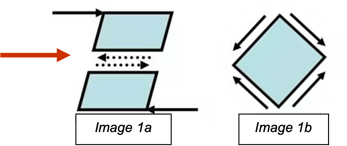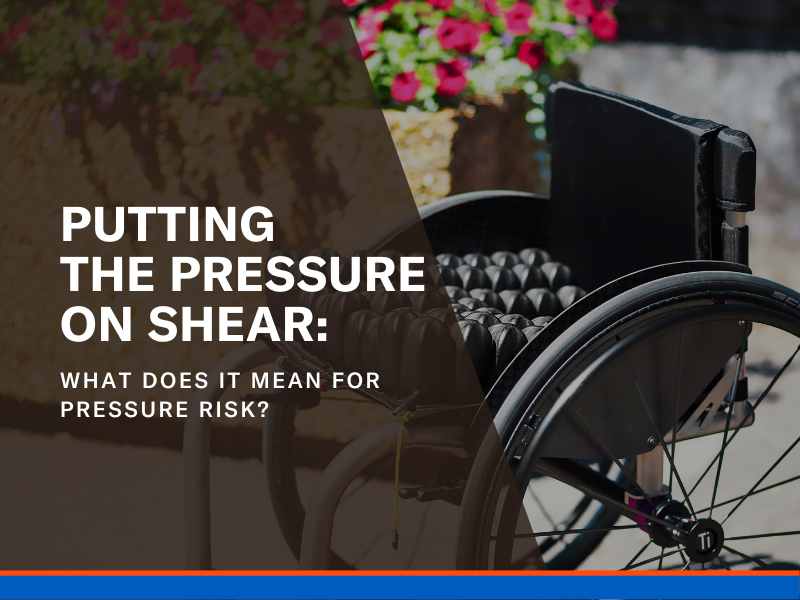The 2023 Worldwide Pressure Injury Prevention Day is to be celebrated on Thursday, November 16, 2023, and in the spirit of this day, I wanted to tackle a term we may be familiar with, but perhaps still struggle to understand; shear.
If you have had any experience or involvement in the world of pressure injuries and prevention, you have most likely heard of the term ‘shear’. However, understanding what this is and how it relates not only to pressure injuries but how it is differentiated from friction, can be more complicated.
Let’s first briefly go over friction. Friction is defined as the resistance by the surfaces that are in contact when they move past each other, caused by the irregularities on the two surfaces in contact (the ‘coefficient of friction’). The rougher the surface/s (the more irregularities), the harder it is for movement to occur and the more significant the friction.
In basic terms relating to this context: the easier the skin can slide across a support surface, the less friction there will be.
Think about new shoes and how they can rub on specific location of your foot, this is likely friction at work creating a red area or even a blister. This though is NOT a pressure injury – just a friction blister. So why is friction even a factor for pressure injuries, you may ask? Blisters and abrasions damage the layer(s) of the skin which can lead this area to be more vulnerable to pressure and shear, and therefore pressure injury development.
I would highly encourage you to review the Clinical Practice Guidelines, an invaluable resource when understanding pressure injuries and how to respond. This also explores the involvement of friction and that when friction is combined with other extrinsic factors such as shear, temperature and microclimate. Temperature and microclimate impact the surface ‘irregularities’, therefore increasing friction. In real life though, this is not only relevant to the outer skin layer as attempts, successful or not, to overcome the surface irregularities have flow-on effects in the deeper layers of the skin, which can then also contribute to shear forces. This is why friction and shear are so often discussed together as friction can lead to shear and therefore solutions need to be explored together.
Shear is a mechanical force, such as tensile forces (pulling) and compressive forces (pushing) are. What’s unique about shear forces in someone’s body is the contribution of both tensile and compressive forces, with shear being the cross-sectional direction of force.
 In image 1a, the black arrows are force directions resulting in the red arrow which demonstrates the shear force. Look to image 1b where a shear force is created on the square through the corners with the facing black arrows being compressive (compressing/ squishing), and the corners with them facing away being tensile (pulling/ stretching).
In image 1a, the black arrows are force directions resulting in the red arrow which demonstrates the shear force. Look to image 1b where a shear force is created on the square through the corners with the facing black arrows being compressive (compressing/ squishing), and the corners with them facing away being tensile (pulling/ stretching).
Shear forces often result in shear strain, and it is these forces occurring in perpendicular directions to normal forces (tensile and compression) that compromise the blood supply creating ischemia and deformation leading to cellular death and tissue necrosis. Consider image 1b being a red blood cell and the impact these forces can have on the membrane’s structure which can lead to changed pH levels, at worst causing cell death.
 Let’s use this image to help understand shear a little more. There is the normal compressive force of sitting (gravity & your weight) between your ischial tuberosities (sitting bones) compressing everything between them and the seat surface. If you leaned as far as you could forward and back and side-to-side– there are many more directions of forces involved in this same already compressed area! We don’t just sit statically, especially as we fatigue, move and transfer.
Let’s use this image to help understand shear a little more. There is the normal compressive force of sitting (gravity & your weight) between your ischial tuberosities (sitting bones) compressing everything between them and the seat surface. If you leaned as far as you could forward and back and side-to-side– there are many more directions of forces involved in this same already compressed area! We don’t just sit statically, especially as we fatigue, move and transfer.
Relating to sitting or lying, think of shear as pulling the bones of the pelvis in one direction and the skin in the opposite direction: the deeper connective tissues slide downward with the bone, but the superficial connective tissues remain attached to dermal skin layer. Coming back full circle, additionally consider in this example how friction (or how easily the skin can or cannot slide across a surface) can then exacerbate the connective tissues at multiple depths even before this may be visibly apparent.
For our users, it is these multi-directional forces which can lead to deep tissue pressure injuries. During this 2023 Worldwide Pressure Injury Prevention Day, I’d encourage you to consider the mechanics of posture, repositioning and transfers for each client, and explore ways to minimise friction and shearing forces. Together, we can work to reduce the incidence and progression of pressure injuries for our users.
Images:
- Bridges. (n.d.). Shear. In The 3 ways in which a material is strong. https://bridges.myengineeringsystems.co.uk/Pages/HowtoreadabridgeStrong.html
- International review. Pressure ulcer prevention: pressure, shear, friction and microclimate in control. A consensus document. London: Wounds International, 2010.
Author

Roseanna Tegel, BHthSc/ MOT
Clinical Services Specialist
Roseanna Tegel joined Permobil in May 2023 as a Clinical Services Specialist. She graduated from Western Sydney University in 2016 with a Bachelor of Health Science/Master of Occupational Therapy and received the Prize in Undergraduate Occupational Therapy for Overall Achievement and the Cerebral Palsy Alliance scholarship. Roseanna began working at residential aged care facilities where her understanding of the need for suitable, person-centred equipment commenced. From there, she transitioned to work in community disability and quickly developed an interest for complex seating and mobility outcomes to benefit both the end user and wider network. She then stepped into a Team Leader role due to her passion for learning and best practice; supporting the Occupational Therapists with their own clinical needs and outcomes, and progressed to also provide external supervision to Occupational Therapists. Roseanna is motivated to support clinicians with their confidence and clinical reasoning allowing them to provide the best outcome for each individual user. Outside of work, Roseanna enjoys time with her dog, playing the 'cello, horse riding and aerial sports.
